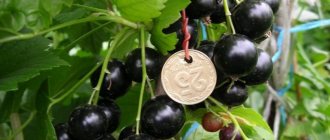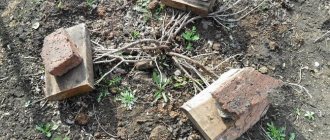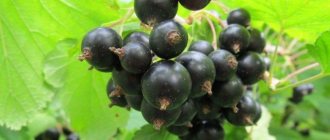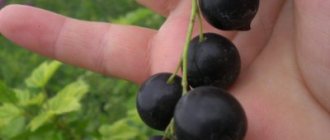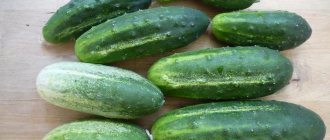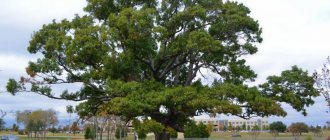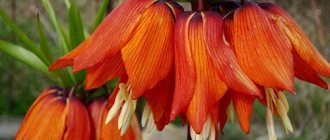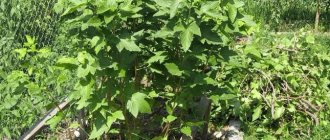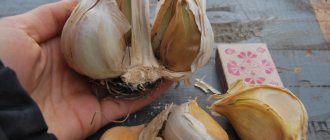Since ancient times, currants have been the most widespread berry crop in Russia. Currant Exotica is good, but not ideal. We will talk about the advantages and disadvantages of the variety below.
Blackcurrant “Exotic”
“Exotica” variety suitable for industrial cultivation
black currant “Exotic” with good taste characteristics, universal use
Description of black currant Exotic
The plant is strong - with straight, not too massive shoots. Young stems are clean, light green in color, quite dense, and have plant pigments.
Adult shoots are straight, gray in color. The buds are ovoid, asymmetrically located on a short stem, slightly deviated from the main stem, quite large, pink in color.
The leaves are very large, consist of 5 lobes, are green, and have a corrugated appearance. The flowers are pale, large, the sepals are small in size.
The cluster is small, a bit like a bunch of grapes, with large shiny black berries, equally round with thin skin. Sweet and sour, aromatic.
This variety is winter-hardy, capable of bearing fruit quickly after planting, and does not require cross-pollination.
Appearance, characteristics of berries, ripening time, yield
An adult plant reaches a height of 1.3–1.5 m, while forming a lush bush with thick vertical shoots covered with gray-beige bark, which has an elastic, smooth structure. With age, the stem sheath becomes deformed, and on branches older than 5 years it becomes cracked, rough, and partially covered with green mold.
Important! For black currants, the lack of moisture during the periods of flowering, fruit formation and harvest ripening is critical. This leads to the fact that the berries become smaller and lose their juiciness.
The description of the variety states that Exotica is an early-ripening variety of black currant, and its flowering begins in the last ten days of April. In this case, the plant is covered with large (0.4–0.6 mm) whitish flowers, collected in long inflorescences in the form of earrings. Ripening begins in early July, depending on the climate in which the shrub is grown.
It is one of the largest-fruited representatives of its species; the berries are medium and large, weighing from 3.5 g to 6.5 g, have thin black skin without shine, and are collected in fruit clusters, each of which consists of 8–12 fruits. The fruits have a sweet and sour dessert taste with a strong currant aroma, thanks to which the variety is rightfully recognized as one of the most delicious. With good lighting and soil moisture, the yield from an adult bush reaches 3.5 kg.
Exotica's frost resistance is very high; it can withstand winters with frosts down to –25°C without damage, so it can be grown almost anywhere in the Russian Federation. Also, the bush can survive long-term droughts without damaging the root or above-ground parts, but if the gardener wants to get a high-quality harvest of large and tasty fruits, then in the absence of natural precipitation the plantation should be watered.
Did you know? Different types of currants differ in nutritional value: black berries contain more fiber compared to red and white fruits. This property makes them very useful for human digestion.
The shrub has green, slightly corrugated leaves, reaching a diameter of 8–10 cm. The moderately dissected plate consists of 5 lobes and is attached to the plant by a strong petiole up to 7 cm long. The thickness of the shoots related to the current year's growth varies from 0.8 to 1 .2 cm, perennial shoots have a diameter of 3 to 5 cm.
The variety is partially self-fertile (up to 54%) and is capable of producing a crop without additional pollination. But still, the plant will show stable high yield if several other varieties of crops are planted nearby, for example, Yadrenaya or Selechenskaya currants.
Black currants contain a large amount of beneficial substances such as vitamins, minerals and antioxidants, ideal for maintaining the health of the human body. These fruits are rich in vitamin C, which helps fight infections and protect the immune system from diseases such as flu or colds, so common in the cold season. In addition, this vitamin also contains many antioxidants that fight against cell aging and the formation of free radicals.
Important! When carrying out preventive or protective treatments of currant bushes using chemicals, the gardener needs to protect the face, body, organs of vision and breathing from exposure to aggressive substances. For these purposes, the employee is required to use protective clothing, goggles and a respirator.
The berries also have a high content of vitamin B, especially B5 (pantothenic acid), which is involved in fat metabolism and in maintaining the nervous system. B3 (niacin) is also present, which promotes energy production, improves circulation and regulates blood flow.
Black currants provide the body with a significant amount of vitamin A, potassium, iron, magnesium, calcium and proteins. It has anti-inflammatory and anti-rheumatic properties, making it an ideal fruit for relieving muscle pain after a hard workout. The high fiber content of the fruit helps regulate the digestive system and helps you avoid health problems such as constipation or other serious diseases. The content of vitamin C in black currant berries is so high that even lemons have less of this substance.
Drinking blackcurrant juice is highly recommended by doctors, as numerous studies have shown that it is an excellent way to avoid diseases such as dementia or Alzheimer's disease. It is low in calories, so the product is used to cleanse the body or as a dietary supplement, and also helps reduce cholesterol levels in the blood.
Video: Exotic currant variety
Advantages and disadvantages
Exotic black currant has many advantages that attract gardeners. However, there are also flaws. Let's consider the pros and cons of the variety.
Positive points:
- large berries;
- high resistance to pests and diseases typical of currants;
- high vitality in severe frost conditions;
- early ripeness and abundant yield;
- excellent transportability of berries;
- long shelf life of the crop.
The negative aspects include:
- return frosts can harm early flowering;
- intolerance to lack of moisture;
- weak resistance to some diseases.
Watch a review of the “Exotic” blackcurrant variety in the video below:
Landing
It is recommended to plant Exotic currants in the autumn months. In the southern regions, transfer to open ground is possible until October, and in areas with a northern climate in August or early September.
The site should be sunny, sheltered from the wind. It is not recommended to plant blackcurrant Exotic seedlings in lowlands. The optimal location of the bush is a western gentle slope.
It is better to take a two-year-old seedling, without visible damage and with a closed root system
Before planting, prepare a hole up to 40 cm deep and 0.5 m in diameter. The procedure must be carried out 15-20 days before transferring the Exotic blackcurrant seedling into open ground, so that the soil has time to settle. The soil from the hole must be mixed with manure and ash, superphosphate.
Landing algorithm:
- Pour a bucket of water into the hole.
- Place the seedling in the hole, deepening the neck by 10 cm.
- Bury the roots of the bush so that they are evenly distributed throughout the hole.
- Lightly compact and mulch the ground around the Exotic currant seedlings.
For uniform growth and development of the bush, it must be trimmed so that only three buds remain.
Preparing for landing
By listening to the advice of experts, the planting process will become easy and enjoyable for you.
To purchase seedlings, contact specialized nurseries, garden stores, or gardeners you trust. This way you will avoid buying low-quality goods.
The best solution is to find a nursery in the same area where your garden plot is located, or a little further north. Plants purchased from these nurseries are adapted to the climate of your region.
Purchasing seedlings
When choosing additives, pay special attention to the root system. The roots must be strong and healthy, have at least 3 main root shoots 20 cm long. It is unlikely that short roots will take root well.
Carefully inspect the seedlings for damage or rotten areas. The root system must be powerful.
Choose a seedling with elastic and healthy shoots, dense and uniform in color. Buy two-year-old seedlings - these take root better.
Choose seedlings in containers. They are planted with existing soil, which will allow the plant to quickly and better adapt to new conditions.
Selecting a location
Blackcurrant Exotica, despite its northern origin, loves warmth and light. Set aside the sunniest and most well-warmed area in the garden for this variety.
Make sure that the air does not stagnate. Protect the seedlings from the harsh and severe north wind - this is important.
The distance to groundwater at the site where bushes are planted should be 2 m or deeper. This condition will allow the root system to develop successfully.
Select date
Exotic seedlings are planted in spring and autumn. If you purchase a pet with an open root system, start planting in mid-autumn or the first ten days of October.
Young roots must adapt before the onset of severe cold. The bushes get used to the new soil and with the onset of spring they quickly grow.
The situation is different with a seedling in a container. No adaptation of the root system to new conditions is necessary. Therefore, such young trees can be planted both in autumn and spring.
Site preparation
Before planting plants, gardeners select and prepare the area.
Give preference to an open, draft-free place. If the seedlings are planted in the shade, the bushes will stretch out and the size of the berries will greatly decrease. Clear the area for planting currants from weeds, carefully level it, removing any uneven areas.
Blackcurrant Exotica prefers not too acidic soil.
Landing Features
Optimal timing
The best time to plant Exotics is autumn. It is advisable to do it before the first frosts, so the end of September - the beginning of October, when the temperature is between 8–15°C, is the most favorable period. During the winter, the earth will settle well and compact around the root system, and in the spring the currants will give good growth after awakening.
You can plant Exotics in the spring, but it is undesirable to do this for the reason that rapid bud break will not allow the plant to take root well.
Site preparation
Blackcurrant Exotica prefers moist soil. Therefore, choose a site on the north or northwest side of the garden. The main thing is that the place is protected from strong winds. The area where black currants are supposed to be planted must be spacious and well lit, otherwise the bush will begin to stretch out and the berries will become smaller.
Exotics are undemanding to the soil if you dig the planting hole correctly and add the necessary fertilizers. The main thing is that the soil is not acidic. But this can also be corrected by liming. If black currants are grown on sandy loam soil, good watering will be required.
Do not plant Exotica in waterlogged soils, as this may lead to the death of the bush.
The place for planting black currant Exotic should be sunny and protected from the wind.
Before planting, it is necessary to carry out preparatory work, which includes the following steps:
- Leveling the ground area.
- Digging and clearing of remaining vegetation. The easiest way to accomplish this task is to use a pitchfork.
The best predecessors for currants are perennial grasses and row crops: for example, potatoes or corn.
Selection of seedlings
A correctly chosen seedling is the key to a healthy plant that brings generous harvests. It is advisable to buy seedlings from nurseries or trusted sellers.
When choosing planting material, pay attention to the following points:
- The bush is supposed to have good, strong branches and a developed root system. The size of the roots is at least 20 cm in length.
- There should be no rotting or damage to the root system.
- It is advisable that the seedling be two years old. These take root and bear fruit better.
Black currant Exotica is a partially self-fertile variety. Therefore, to increase the yield and increase the mass of berries, you need to plant several varieties for cross-pollination.
Two-year-old seedlings have a very high survival rate
Disembarkation process
- We dig a hole 2 weeks before the planned planting date. Its volume should be 2 times larger than the root system of the seedling. Typically these are the following dimensions: width - 50 cm, depth - 40 cm.
- We add useful substances and fertilizers: 1 bucket of rotted manure, 300 g of ash and 200 g of superphosphate. Mix with added topsoil.
- We plant the plant at an angle, 8–10 cm deeper than the seedling grew in the nursery. This is necessary to create a sufficient supply of root buds.
- Pour at least 10 liters of water under the seedling and mulch with peat to prevent moisture loss.
When planting Exotic black currants, the distance between the bushes should be at least 1 m. The distance to the nearest fence or wall should also be at least 1 m. The part of the bush that is very close to the fence will not produce a crop.
The hole should be about half a meter wide
Algorithm for planting Exotic currants
Maintain the correct distance between seedlings or bushes and any fence. It should be 1 m, you can increase the gap, but not too much (1.3 m). Otherwise, Exotic currants will not please you with a bountiful harvest.
Features of planting and caring for black currants can be found in this article.
Proceed to the step-by-step planting process:
- On a leveled and cleared plot, dig holes with dimensions: diameter 40-50 cm, depth up to 30 cm.
- Fill the holes with useful substances: use a mixture of a bucket of compost, superphosphate (200 g), wood ash (300 g) and a small amount of soil.
- Bury the seedling into fertilized soil at a slight slope from 8 cm to 10 cm above the root collar, the angle of inclination is within 45 degrees.
- Be sure to spread the roots along the bottom of the hole, do not allow them to be positioned upward.
- Pay attention to the buds at the bottom of the stem; they should remain underground.
- Use pruning shears to cut off the remaining branches of the bush.
- Pour a bucket of water into the prepared hole with the seedling.
- To retain moisture, fill the hole with soil mixed with peat.
- The final step is to lightly compact the soil.
The landing is complete. Now high productivity depends only on proper attitude towards plants.
Care
With proper care throughout the entire growth period (lifetime 20-25 years) of the variety - from the moment of planting to full ripening and harvesting, chokeberry Exotica has high fertility, lush growth of the bush, and high yield.
Watering
The exotic is a moisture-loving crop and can slow down growth due to insufficient watering, but it does not like stagnation of moisture at the roots. Agrotechnical irrigation methods:
- Spring watering during shoot growth is done once per season, and the soil should be well warmed and moistened to a depth of 30-40 cm. It is better to water with warm water (warmed up in the sun);
- Summer watering should be sufficient. To do this: make grooves around the perimeter of the bush at a distance of 20-30 cm from the end of the branches, with a depth of 10 cm, and it is into these grooves that water is poured. The best option in dry weather is 1 ruble/7-10 days, 40-50 liters of water at the root of each plant.
- After leaf fall, water-recharging irrigation is done.
Severe dryness of the soil, during the period of growth and filling of Exotic varietal fruits, leads to their crushing or shedding of part of the crop.
Pruning and shaping the bush
Properly performed pruning and correct shaping of the Exotics allow the shrub to develop qualitatively, produce large growth, and form a significant amount of ovary. The range of activities includes:
- Regular shaping pruning. In the 1st year of growth - post-planting shortening of shoots leaving 2-3 buds. In the 2nd year, the shoots are cut out, 3-5 strong shoots are left, the tops of the remaining branches are cut off into 2 buds. In the 3-4th year, 5-8 skeletal branches are left as the main shoots, the upper part of the branches is cut off into 2-3 buds. In subsequent years, the bush maintains the growth of 10-15 skeletal branches, periodically replacing them with younger ones. The base of the bush should be wide, with its middle well lit.
- Sanitary pruning and crown thinning can be carried out all year round. All non-viable, broken, deformed, growing in the center of the bush, intertwined, with signs of disease, shoots and branches growing horizontally must be removed.
- Rejuvenating. Performed 5-7 years after planting, it involves cutting out old, unproductive branches and leaving “zero” shoots growing from the root.
Pruning must be done carefully, using only sharp pruning shears or a saw. You cannot cut it off with a knife, break it off, or unscrew it - the bush after such traumatic procedures will have difficulty growing in the spring.
Top dressing
Without the timely application of vitamin and mineral support, the root and vegetative system of the currant bush ceases to fully develop, the plant will begin to significantly reduce productivity, get sick and suffer from attacks by harmful insects.
- In the spring, during the beginning of the growing season, it is worth fertilizing the currants with complex fertilizers. You can perform foliar feeding with organic microfertilizers in chelated form. They will have a positive effect on the growth and development of buds, young leaves, and stems.
- In the summer, during the periods after pollination and the beginning of ripening, they are fed with liquid organic matter based on bird droppings or mullein, and single-component mineral supplements are also used.
- In the fall, after picking the berries, stop adding nitrogen-containing compounds. Mineral compounds containing manganese, zinc, potassium, copper, and phosphorus are applied outside the root or under the root. It is good to enrich the soil with wood ash, humus, and compost.
Aeonium care at home Reproduction of Aeonium tree-like black and other types of photos
Reproduction
Vegetative methods for propagating a new planting are suitable for propagating the chokeberry variety:
- Arc-shaped biennial processes. To do this, bend it to the ground, place it in a shallow horizontal hole and dig in a branch growing on the periphery, 2 years old. After abundant summer watering, the cuttings will sprout roots and shoots by autumn, which are then cut off from the bush and replanted in a permanent place. The technique gives almost 100% survival rate;
- Lignified cuttings. Such cuttings are prepared during the dormant period of the plant, from the root or basal trunks (their middle part) of 3-5 year old fruit-bearing bushes. In the southern regions, the chopped petioles are immediately planted in a school of open ground; in the middle and northern latitudes they are placed in containers with soil and brought into a warm room. After rooting, they are moved to open ground in the spring. The survival rate of cuttings is up to 80-90%.
The area where the cuttings will take root must be well fertilized and located so that the planted plant can be shaded from direct sunlight.
Protection from winter cold
Although Exotica is considered a frost-resistant plant (withstands -25°), when grown in the middle and northern regions, winter temperatures can drop significantly. Therefore, experts advise:
- Bend the branches to the ground in different directions, press them with several bricks, slate or tiles and sprinkle them with earth. After snow falls, a snow mound 10-15 cm high is raked onto the base of the plant.
- Wrap each branch separately or several branches with insulating agrofibre, and lay mineral wool.
- Mulch the root surface with fresh organic matter.
This link will tell you about the description of the Golubka currant variety.
Caring for currant bushes
Caring for Exotics is traditional and includes: watering, loosening the soil, mulching, pruning, weed control, fertilizing, preventive measures to destroy pests, and treatment of shrubs. More is written about caring for currants in the fall here.
By observing all the care conditions, you will achieve a high, high-quality and tasty harvest. Let's look step by step at the points of caring for shrubs.
On our website you can find information on how to properly care for currants in the spring.
Watering
A special feature of the procedure is scrupulous regularity. Monitor the watering process during dry spring and early summer. At least 1-2 buckets of water are added to each bush once a week.
Be sure to keep a substantial layer of mulch under the seedlings to prevent moisture evaporation. Stop watering as soon as clusters form and the berries begin to ripen. The harvest will be juicy.
Experienced gardeners advise: sprinkling irrigation is suitable for this variety, since Exotica is resistant to powdery mildew.
Trimming
You will achieve high yields if you take the trouble to form the bushes correctly. In the 2nd year, the young bush will produce many zero shoots from the center of the plant.
With the onset of autumn, trim the resulting growth on the branches by 1/3, and remove new shoots. But not all of them - leave 3-4 of the strongest and most viable branches. 1:1 repeat this procedure after 3 years, again in the fall.
About the correct pruning of currants in the fall is written here.
Throughout the entire fruiting period, maintain the bush in an unthickened state, leaving no more than 12 shoots. Prune annually, and cut out branches that are older than 4 years completely.
Read our article on how to prune currants in spring.
Loosening and mulching
Cultivating the soil protects it from rapid drying out, and also generously enriches the soil with oxygen and destroys weed seedlings. If the mulch layer under the bush consists of humus, try to loosen the soil to a depth of no more than 9 cm, but not less than 6 cm.
If the shelter is made of other components, proceed as follows: move the mulch away from the bush, loosen it to a depth of 5 cm, then cover the ground under the bush again.
Perform this procedure monthly (once is enough) from the moment the kidneys swell. If it rains frequently, loosen the soil more often to prevent compaction of the soil clod.
Fertilizer
After planting Exotic blackcurrant seedlings, care for a couple of years comes down to watering, mulching, and exterminating all kinds of weeds. As the plant gets older, it needs feeding. During each fertilization period, different fertilizers and their mode of use are required. Read this article for useful tips on applying spring fertilizing.
As soon as the snow melts, scatter bone meal and urea under the Exotica bushes (2 tablespoons for each seedling). Then cover thoroughly with humus, the layer of which should be up to 10 cm. Finally, water generously.
Also feed your pets with an infusion of fermented grass. Add 1 liter of the composition to a bucket of water - feed each bush with this amount. Cover the tree trunk soil with compost, use the grass after creating the infusion.
After a week, make a groove around the perimeter of the bush, fill it with 2 cups of wood ash and mulch. Carry out this procedure in June, as soon as ovaries form on the bushes.
After harvesting, feed the plants again with ash. In late autumn, add a bucket of humus or compost under each bush.
Read about how and what to fertilize currants in the autumn here.
Preparing for winter
Before the onset of frost (no later than October), prepare the Exotic for wintering. Be sure to inspect the bushes to identify branches that need to be removed.
Feed the plants, dig up the soil, but shallowly, and mulch the tree trunk. Various materials, even snowdrifts, can serve as shelter options.
Agricultural technology
In order for the Exotics' yield to be pleasing, the garden owner must provide the plant with timely care: watering, weeding, pruning, treatment against pests and diseases.
Choosing a place and landing
Currants have high requirements for good lighting, but if necessary, the crop bears fruit well in partial shade. Loves loose, fertile and well-drained soil with a neutral or alkaline pH. Does not tolerate stagnant water, as this causes rotting of the roots. Too acidic soils cause the crop to develop chlorosis, which leads to the appearance of discolored leaf blades with green veins. This pathology is associated with poor absorption of iron by the plant. The optimal pH value for the crop is from 5.5 to 6.5. The acidity of the planting substrate can be reduced by adding lime or chalk powder to it.
We suggest that you familiarize yourself with information about where it is better to plant currants - in the shade or in the sun.
Planting currants can be done in spring or autumn, but experts recommend the second option, since this period contributes to the rapid adaptation and rooting of plants. The first recommended step is soil analysis and its preliminary preparation, which includes cleaning the surface of the earth from plant residues (if necessary), then digging to a depth of about 30 cm and sampling the roots of perennial weeds.
It is best to plant seedlings soon after acquisition, but if it is necessary to postpone this procedure for some time, then it is advisable to place their roots in a moist substrate. Planting material must be purchased from a nursery, which can provide a guarantee of varietal purity and plant health.
When planting several shrubs in a row, the gardener is recommended to maintain a distance between them of 1 m to 1.5 m. If a large plantation is being planted and there will be several rows, then intervals between the rows are created (2.5–3 m).
How to plant currants:
- First you need to dig a planting hole measuring 30x30x30 cm. A hole of this size should be sufficient, but to make sure of this, the gardener should try to place the root system of the seedling in it for testing.
- Place 3–5 kg of organic fertilizers (manure, humus, compost), wood ash (500 ml), crumpled eggshells into the pit and mix well until smooth.
- The bush is placed in a vertical position in the center of the recess, after which the roots of the plant are evenly covered with soil.
- The soil around the planted plant is compacted and well watered.
Video: How to plant black currants
Care
Despite the drought resistance of the variety, in the absence of rain in the summer, Exotica must be watered at least three times a month, using at least 10 liters of water per bush. When supplying moisture to the plant, the gardener should be guided by a visual inspection of the soil; if the soil is wet, there is no need for irrigation. This is important, because prolonged waterlogging leads to the formation of root rot on currants. Before reaching the age of 3 years, the bush is not fertilized, since the young plant only needs the nutrients that were placed under the root before planting.
You may be interested in information on how to properly tie up a bush.
Adult bushes are fed annually with organic matter (these substances are rich in nitrogen), choosing the autumn period for this. It is recommended to take well-rotted cattle manure, humus, compost or liquid green fertilizer.
For one adult plant, 10–12 kg of organic matter is enough, which is evenly laid out in the circle around the trunk, and then dug in with the soil. The space under the bushes must be kept free of weeds, so it must be weeded regularly, as well as loosen the soil to provide oxygen access to the roots of the plant.
Disease and pest control
A gardener can achieve full fruiting only from a well-developed, healthy bush. Unfortunately, the crop is periodically exposed to both the invasion of insect pests and various diseases.
About
Reproduction of Exotics
The simplest and most commonly used method of propagation is cuttings. From one-year-old shoots, cut cuttings from 15 cm to 20 cm in length, use only healthy shoots.
Make a solution of humic acid salt and place the cuttings in it for 12 hours. Then plant in prepared soil.
To speed up the formation of a new blackcurrant bush, plant 2 or 3 cuttings in one hole. An important point is that the cuttings must be of the same variety and they must be laid crosswise.
Do not forget about the distance - 15 cm between petioles and half a meter between rows. Tilt the base to the south and the top of the cut branch to the north.
The second propagation option is to bend the lower branch of the bush to the ground and then bury it (the top of the branch should be above the soil surface). After some time, the shoot will take root.
Harvest and storage
It is better to collect exotics together with the comb, since tearing off an individual berry often leads to rupture of the berry skin and leakage of juice. Dry twigs, leaves, rotten berries are removed. Place in shallow but wide boxes, small buckets, baskets. You can store the harvest:
- Drying the berries.
- By freezing them. Storage duration is up to 12 months.
- Fresh in the refrigerator or in a cool, dark room, pouring the berries into glass containers of any size, in small portions, in a thin layer in bags. Storage time is up to 40-60 days.
Collection, storage and use of berries
Exotic berries ripen in early July. Do not delay harvesting, otherwise it will crumble.
Pick blackcurrants by hand (this method is gentle), but if acceptable mechanisms are available, use them calmly. Manual harvesting keeps the berries in the refrigerator much longer.
Time the harvest to coincide with dry weather. For storage, pick whole bunches of berries, choose a small container. If desired, you can store Exotic from 10 days to 1.5 months (the period depends on the selected temperature).
It is best to eat the berries fresh. If you want to stock up on them, make jam or compote, grind currants with sugar, prepare juice, puree, freeze the berries. This way you can replenish your vitamin supply during the winter.
Characteristics
Among all the early varieties of Russian breeders, the Exotic blackcurrant is the largest-fruited.
The plant is partially self-fertile: it does not require the proximity of other shrubs. But the maximum yields are recorded by gardeners who planted Yadrenaya or Selechenskaya currants nearby.
The variety has a strong immune system: it is not afraid of columnar rust, powdery mildew and bud mite. With proper care, the shrub does not suffer from anthracnose, septoria and terry disease.
Important! The variety is recommended to be grown in the Central or Siberian regions.
Drought resistance, frost resistance
Exotic black currant tolerates low temperatures well. The crop can be grown in regions where winter temperatures reach -26°C. At lower temperatures, the bush needs shelter.
According to the description of the variety and photo, Exotic black currant is able to withstand drought for a long time. But reviews claim that although the above-ground part of the plant and roots are not affected, the yield without sufficient moisture is significantly reduced.
During prolonged rains, the crop may suffer from fungal diseases
Productivity
The first ripe berries can be picked in early July. The yield from each bush with proper care is 3-3.5 kg.
When cultivating the variety on an industrial scale, from 1 hectare you can harvest from 1.5 to 5.1 tons of berries
Excess moisture and late frosts during the flowering period of currants have a negative effect on fruiting indicators.
Important! When overripe, the berries may fall off.
Application area
The variety is intended for fresh consumption or canning. The berries make delicious jam or jam. It is also possible to freeze fruits that have been previously crushed to a puree state.
When harvesting, a large amount of juice is released from the berries, so Exotic black currants are not intended for long-term transportation
Important! If the skin of the berry is not damaged, then such currants can be kept fresh for ten days. Frozen fruits should be eaten within six months after picking.
Susceptibility to diseases and parasites
Compliance with the rules of care, careful attention to plants and prevention is the key to ensuring that the currants do not get sick. Exotics have an innate immunity to diseases such as columnar rust and powdery mildew.
But Exotica doesn’t have the strength to fight all the adversities on her own. Your help with this is simply needed. How best to do this:
- Anthracnose is a disease of leaves, petioles, and young shoots. In 2-3 years it leads to the death of the bush. For prevention purposes, do not form the bush too dense. In the fall, after dropping the leaves, spray the bushes and the ground underneath them with a seven percent urea solution. In the spring, go over the young leaves with a solution of Fitosporin, add 2-3 drops of Zircon and Epin-extra to it. In case of illness, spray the plant with the same preparation (carefully read the instructions). In the fall, collect fallen leaves and burn them, treat the bushes and soil with a solution of copper sulfate. In spring, spray with one percent Bordeaux mixture.
- Terry disease is a viral disease. Cannot be treated. Infected bushes are destroyed; under no circumstances throw them into the compost pit. Prevention is the fight against sucking insects that spread the disease.
- Septoria blight is a foliar disease. Leads to loss of winter hardiness. Preventive methods and treatment methods are identical to those for anthracnose.
- Kidney mite - affects the kidneys and spreads the terry virus. If the bush is highly infected, it dies. Inspect the plants carefully. Swollen buds are a sign of mite infestation. If detected, remove immediately. Before the buds open (in early spring) and with the onset of late autumn, treat the bushes with boiling water.
- Aphids (another name is shoot aphid ) - reproduces on the tips of young shoots. The leaves are deformed and firmly glued together. For prevention, spray Exotic bushes every decade with Fitoverm. If there is a large accumulation of aphids, add green soap to this preparation and rinse the infected ends of the branches. Find more information about aphid control products here.
- Glasswort is a butterfly caterpillar. It can completely destroy the core of the bush, causing the branches to dry out. Spraying is similar to treatment for anthracnose. Do not plant Exotica near bird cherry, it is on it that the glassberry lives and reproduces.
- The gooseberry moth is a caterpillar. It strongly entangles fruits, eats seeds, and lays eggs in buds. The result is damaged berries, a spoiled harvest. Remove the caterpillars along with the berries; during the formation of buds and until the very beginning of flowering, treat with the same preparation as when fighting aphids, every 10 days. Cover the soil under the bushes with a thick layer of mulch from old newspapers - they will reliably protect the ground from the emergence of a wintering butterfly.
- Currant leaf gall midge is harmful to leaf development. The larvae feed exclusively on leaf pulp. Fruiting may not occur on damaged bushes. As a preventative measure, after harvesting, remove and burn the infected branches. Water and feed Exotica, mulch the soil over a large radius. If the larvae have already damaged the leaves, spray the black currants with a solution of karbofos. Carry out this procedure before flowering, at its completion, after picking the berries.
Description of the variety
Exotica has an upright, dense bush. He grows tall. The berries grow round, the fruits vary in size and weight - up to 5 grams. One bush contains about 10 berries, which are collected in clusters. It is recommended to grow fruits in the central regions.
The variety has the following characteristics:
- withstands frost and drought, rarely dies in harsh weather conditions;
- self-fertile;
- fruits grow quickly;
- not susceptible to certain diseases;
- ripens early;
- difficult to transport;
- a harvest of up to four kilograms per bush.
In hot weather, you should water the berries more often. In very rainy weather, on the contrary, you should refrain from watering.
Reviews from gardeners about Exotic currants
★★★★★
Tatyana, 54 years old, gardener. I highly appreciate the taste qualities of Exotica, the rich aroma of berries.
I would like to draw the attention of beginning amateur gardeners to the fact that it is necessary to take into account the specific conditions for the quality growth and fruiting of this type of crop. Of all the varieties that I planted earlier, I kept only Exotic. ★★★★★
Stepan Ilyich, 62 years old, amateur gardener. I bought seedlings, but they froze.
But it was my mistake. So when purchasing seedlings, be guided by the area in which you are going to grow Exotics. ★★★★★
Evgeniy, 35 years old, summer resident. Having encountered a rainy period during the Exotic harvest, I now focus the attention of amateur gardeners on weather conditions.
Harvesting should not be delayed, especially if the weather is hot during this period. Be careful when choosing this blackcurrant variety. Hide
Add your review
There are no ideal plants in nature; each species has a lot of advantages and a certain number of disadvantages. The same can be said about the Exotic blackcurrant variety.
0
0
Copy link
Reviews about the Exotic variety
Tatyana Pustovey : “Exotic currants are my favorite variety. There were a few more on the site: Selechenskaya, Lazy and some others, but I threw away everything except Exotica. The taste is simply great, a huge berry. The only drawback is that the berries fall off if you are a little lazy with picking. I pick the berries with a brush, and then when I send them out for processing, I pick them, so they last longer.”
Tamara Linnik : “The Exotic blackcurrant variety has a really large berry, much larger than the Yadrenaya currant, but the taste of the berries was sour this year, perhaps due to the lack of sun. Selechenskaya was much sweeter, so I’ll focus on it, especially since Exotica takes a lot of time to care for.”
Vadim Butko : “Completely for Exotica. One of the most favorite varieties. The berry is large, not sour, I always eat it without sugar. It grows in the sun and even withstood the summer heat well. The soil is sandy loam, regular watering (2 times a week), fertilizing, mulching and no problems. The bushes are even and do not fall apart, even if the harvest is large. The berries come off normally if you don’t pull, but carefully remove.”
Features of care
Caring for Exotic black currants involves loosening the soil, watering, removing weeds, pruning, treating diseases and pests, and fertilizing.
Important! In the last days of May, you should fill the ground around each bush with peat, compost, mown grass, etc. This will promote looseness of the soil and protect it from overheating and moisture loss
Watering
The Exotica currant variety loves moisture, so young bushes should be watered once every 7-10 days with 10 liters of water, and adult bushes with 30-40 liters. You need to moisten the soil carefully without touching the bush, as this can cause the development of powdery mildew. For irrigation, it is advisable to use water heated in the sun.
Top dressing
- The first feeding is carried out in late March. Water with chicken droppings dissolved in it is poured under each bush (100 g per 10 liters of water).
- During intensive growth of the ovary (in May), the plant is watered with a solution of nitroammophoska (150 g per 10 liters of water).
- In autumn, the bushes are fertilized with a bucket of humus and a glass of ash.
Trimming
Pruning and shaping the bush are very important procedures.
The pruner must be held with the cutting side towards the remaining part of the shoot - this will make the cut more even, in addition, this will avoid crushing the tissues of the branch
Many gardeners believe that the berry harvest will be more abundant if there are many shoots on the bush, but this assumption is incorrect. The basis of the berry harvest is formed on the strong healthy growth of the previous year. The most productive branches of the bush skeleton are 2-3 years old.
- The first time currants are pruned at the time of planting, leaving 3-4 well-developed and healthy shoots with evenly spaced buds.
- 2-3 years after planting, cut off weak, broken, dry, damaged shoots.
Leave 5 conveniently placed and well-developed branches. Scheme of formation of a currant bush - The formation of a bush using pruning ends 4 years after planting, then maintenance pruning is carried out. It consists of removing old branches or branches that have shorter annual growth. Instead of the cut ones, the same number of root shoots is left. If there are few of them, then in addition to the old branches, several younger ones are removed. Maintenance pruning is carried out throughout the life of the bush.
Video: pruning currants
The Exotic variety may be susceptible to the following diseases:
- anthracnose (brown spots on currant leaves caused by excess moisture);
- septoria (rusty-colored spots with a black dot in the middle, resulting from a lack of light, nitrogen, or excess moisture).
Spraying with a 3% solution of copper sulfate, which is carried out before the buds open, will help against the above diseases. Before flowering, the plant is sprayed with Topaz (10 ml per 10 liters of water). After the harvest has been harvested, the bushes are treated as necessary after rain.
The main pests of Exotic currants are glass beetles, aphids, and mites. To prevent the appearance of insects, bushes are sprayed during the growing season with BI-58 (10 ml per 10 liters of water).
Description and characteristics
Currant Exotica is a berry bush with large leathery leaves dotted with small wrinkles. The edges of the leaf blade are serrated. The plant blooms in mid-May with large white flowers, the fruits ripen by mid-July.
Bushes of the Exotic variety are upright, medium dense. Currants of this variety, with proper care, reach the height of human growth. This year's shoots are light green. The old ones are lignified, powerful, and do not bend under the load of the harvest. Mature branches are gray, yellowish at the tops.
Berries
Exotic fruits contain a high concentration of vitamin C. They ripen on a cluster similar to a grape.
The color of the thin-skinned berries is shiny black, spherical in shape. The weight of one piece is 3–5 g, the quantity on the brush reaches 10. The taste of the fleshy pulp is piquant, sweet and sour, refreshing, with a pleasant aroma.
Harvesting
The fruits of the Exotic blackcurrant begin to ripen in early July. The yield from one bush is about 1-1.5 kg.
The Exotic currant variety is characterized by high yield
The berries are versatile because they can be eaten fresh and used to make jam, jam, etc. The fruits can be stored in the refrigerator without losing their beneficial properties for several weeks.
Exotic is a currant variety that is distinguished by its versatility. You can enjoy the berries already in early July, since Exotica is an early variety. To get a decent harvest of berries, the gardener will have to put in a lot of effort, but it’s worth it!
Breeders do not stop working on developing new varieties of currants. Each, according to objective professional descriptions, as well as reviews from summer residents from different regions of the country, has both advantages and disadvantages. Gardeners value early varieties, with large and tasty berries, productive and resistant to diseases. Currant Exotica meets these requirements.
We organize care
The development of bushes, size, taste and quantity of fruits depend on proper care.
Irrigation and fertilizing
Water Exotic currants in dry, clear weather once a week, being careful not to splash the foliage and stems. The bush needs two buckets of water at a time. The variety is especially demanding when it comes to irrigation before budding and filling of berries.
Keeping a plant in one place for a long time depletes the substrate. The crop needs fertilizing with mineral fertilizers and organic matter from early spring to autumn.
Before the buds open, urea is applied under the bushes to promote vegetation. After two weeks, a second feeding is carried out with organic matter rich in nitrogen - infusions of mullein, bird droppings. If preparing fertilizing and manure per bucket of water requires 2 kg, then bird droppings require 1 kg.
From mid-summer and autumn, currants are fertilized with mineral complexes with a predominance of phosphorus, potassium or superphosphate and potassium sulfate. After leaf fall, closer to the cold weather, compost or manure is added under Exotica, which helps the bush to safely overwinter.
Bush formation
Pruning Exotic currant bushes stimulates branching of basal shoots and the regrowth of young branches on old skeletal ones. Thickening and damage to the plant by diseases and pests are prevented.
The first pruning is performed immediately after planting. The shoots are shortened, leaving 3–4 buds. In the second year, they get rid of diseased, thickening shoots. Starting from the third year, old, non-fruit-bearing branches are cut out under the base, leaving 4 powerful basal shoots.
It is mandatory to get rid of disease-damaged and broken branches. If the growth of basal shoots is weak, two skeletal branches are removed, which continue to bear fruit poorly.
Old branches differ from young ones in the darker color of the bark and the smaller size of the buds at the tops. A properly formed adult bush includes 10–15 skeletal branches formed in different years. Each year there are 3-4 branches.
Preparing for winter
Preparatory activities include:
- sanitary pruning of diseased, deformed branches;
- shallow digging of the circle around the trunk;
- abundant watering;
- mulching the ground with sawdust, bark, hay.
In the southern and central regions of Russia, covering material is not used for wintering currants. In the northern regions, branches are wrapped with rope, and the crop is insulated with cardboard and agrofibre. A snowdrift is raked into the base of the bush.
Growing and care
It would be a mistake to think that after planting large-fruited currants, such as Exotica, you just have to wait for the harvest, lounging in an armchair by the fireplace. The quality of the berries and the condition of the bush will directly depend on the planting location and compliance with all care rules. Firstly, the area where currants grow must be in an open and sunny place, otherwise the bush will stretch out and the berries will be crushed. Secondly, plant care plays an important role. Sufficient moistening of the bush followed by mulching is necessary. Among the “little tricks” that help grow full-fledged large berries, gardeners include the proximity of different varieties, the cross-pollination of which helps to increase the yield and size of the fruit.
The video shows dense rows of Exotica currants:
To create a larger supply of root buds, it is necessary to deeply deepen the root collar of the plant during planting (at least 10 centimeters). The timing of planting Exotic seedlings is also of great importance for a high-quality harvest. The best option would be the autumn months (September, October).
The list of measures for caring for the crop includes timely and regular pruning. Without it, the berry plant will grow worse and the yield will noticeably decrease. In addition, the plant is very moisture-loving and requires good watering, especially in the dry season. By following all the rules of care, ideally you can get good yields from the Exotic bush for at least 20 years.
Save the article:
